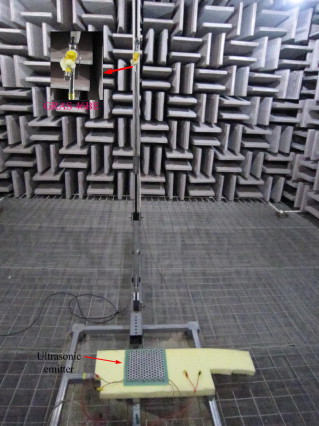For years, the nonlinear interaction of sound waves in air had been applied to directional sound reproduction for audio applications by parametric loudspeakers. As a result of nonlinearity at the receiving system caused by the still existence of the high-level ultrasonic waves, i.e., the primary waves, spurious difference-frequency sound would be generated.
Several methods had already been used before to measure the difference-frequency sound of parametric array, in which most of them adopted an acoustic filter in front of the receiving transducer to reduce the amplitude of the primary waves. Using these proposed acoustic filters, the primary waves at the receiving system were definitely reduced and so did the spurious sound; however, the measured difference-frequency sound was more or less affected. Therefore, a method without using any acoustic filter to measure the difference-frequency sound was much preferred.
So JI Peifeng, LIU Wei, WU Shuaibing and YANG Jun from the Institute of Acoustics, Chinese Academy of Sciences (IACAS) proposed an alternative method to measure the on-axis difference-frequency sound in the parametric loudspeaker without any acoustic filter in the case of weak nonlinearity, which could reduce the effect of nonlinearity on the receiving system. And both the numerical and experimental results were carried out to verify this method.
The numerical results showed that the proposed method could accurately obtain the on-axis difference-frequency sound, no matter the effect of the emitter was considered or not. The levels of the primary waves at the observation point were also reduced as expected, which would alleviate the nonlinear effect on the receiving system.
For the experiment, it was carried out in the anechoic chamber of Institute of Acoustics, Chinese Academy of Science, which had the dimension of 4.8 m (length) × 3.2 m (width) × 6.5 m (height). The cut-off frequency was 70 Hz and the background noise level was 13 dBA. One rectangular-shaped ultrasound emitter was used in this experiment, which consisted of 168 (14 × 12) commercial PZTs (Shanghai Nicera Sensor Type ZT40-16 with a diameter of 16 mm). The G. R. A. S 46BE microphone was used to measure the generated difference-frequency sound and also the primary waves. The experimental parameters were assigned as: f1 = 40 kHz, f2 = 38 kHz, room temperature = 13 °C, and relative humidity = 52%. Limited by the anechoic chamber size, the measuring point was at 2.5 m away from the sound source plane.
The experimental setup was shown below.

Experimental setup

Experimental results of proposed method
The experimental results were given above.
It should be pointed out that the driving voltage to the half emitter are purposely adjusted so as to obtain relative low levels of the primary waves for the half emitter at the measuring point, which had almost no nonlinear effect on the receiving system. That meant the measured difference-frequency sound A for half emitter had almost no spurious sound.
The experiment observed that the spurious difference-frequency sound caused by the product of the primary waves in the receiving system had almost been eliminated because of the special parameter settings. Compared to the direct method derived from the center of one part, the proposed method could not only obtain an accurate axial difference-frequency sound, but also had a relatively lower product of the primary waves at the measuring point.
The method conducted experimentally above was valid for the commonly-used preprocessing methods and also suitable for the case where the emitter constituted of multiple piezoelectric transducers (PZTs) with different frequency responses. Besides, the validity of the proposed method is confirmed by both the simulation and experimental results. The nonlinear effect on the receiving system was found to be relieved and also a more accurate difference-frequency sound could be obtained. The presented analysis was helpful to the practical application in directional audio reproduction systems.
This research result had already been published online and the link is http://www.sciencedirect.com/science/article/pii/S0003682X12000990.


